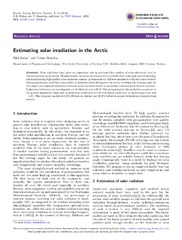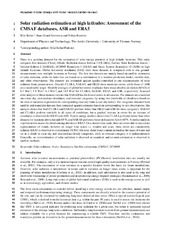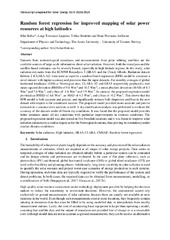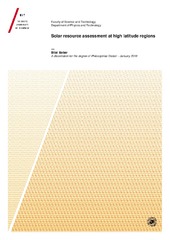| dc.contributor.advisor | Tobias, Bostrom | |
| dc.contributor.author | Babar, Bilal | |
| dc.date.accessioned | 2019-04-17T11:39:36Z | |
| dc.date.available | 2019-04-17T11:39:36Z | |
| dc.date.issued | 2019-03-22 | |
| dc.description.abstract | There has been a growing interest in accurately estimating surface solar radiation at high latitude locations. From a Scandinavian perspective, the installed solar photovoltaic share is increasing, primarily because of the declining cost of these systems, the introduction of various economic incentives and societal push to generate one’s own clean power. In the coming years, it is anticipated that the share of photovoltaics in the energy mix of Scandinavia will increase substantially.
One of the main deterrent in an accurate estimation of surface solar radiation is the limited coverage of geostationary satellites. These satellites, which are widely used globally to estimate solar radiation, do not provide coverage above 65ºN. Alternatively, polar orbiting satellites can be used to estimate surface solar radiation but a low sensing frequency and difficulties in differentiating clouds from snow-covered surfaces result in a large number of missing values in the data. Moreover, reanalyses also provide surface solar radiation estimates and in recent years, it is seen that the accuracy of reanalyses with respect surface solar radiation is getting better.
This thesis starts with providing an evaluation and comparative analyses of different solar radiation datasets for high latitude locations. First, an empirical model based on intra-day temperature differences and relative humidity is proposed. This model can be used at meteorological stations that do not have dedicated equipment to estimate surface solar radiation. Then, a comparative analysis is performed for Norwegian locations in which four different models were evaluated. It was found that satellite databases are more accurate than reanalyses and empirical models. However, satellite databases were found to underestimate solar radiation while reanalyses were found to overestimate it. After this, a study was performed to evaluate the CLARA-A1 and CLARA-A2 polar orbiting satellite based datasets. It was found that the CLARA-A2 dataset has less number of missing values but mostly the increase in data is at snow-covered surfaces. The data in CLARA-A2 has higher accuracy than CLARA-A1, but at these new data points which were previously not available in CLARA-A1, the errors are very large.
Finally, a novel regression-based solar radiation dataset is proposed here that uses one polar orbiting satellite dataset (CLARA-A2), one global reanalysis (ERA5), and auxiliary data based on Sun-Earth geometric relationships. The proposed dataset has better accuracy and precision than CLARA-A2 and ERA5 datasets. | en_US |
| dc.description.doctoraltype | ph.d. | en_US |
| dc.description.popularabstract | Surface solar radiation estimates are used for planning and maintaining energy systems, such as photovoltaic panels or thermal systems. There is a growing interest in the deployment of these systems in arctic regions, but accurate data for these regions is not available. There are only a few stations in the arctic that record such data by dedicated equipment, however, remotely sensed data by satellites or by climate models can be used to estimate solar radiation. In this project, different sources for estimation of solar radiation are analysed. In the first part of this research, extensive validation for both satellite methods and climate models was performed for high latitude regions. It was seen that both of these sources deteriorate with increasing latitude. In the last part of this research, a novel dataset is presented which was constructed by using a satellite dataset and a climate model. The proposed dataset improved the solar radiation estimates at high latitude regions. | en_US |
| dc.description.sponsorship | This work was supported by Troms county and industry development fund under the project title, “Renewable energy in the arctic – academy and business in a joint effort” RDA12/46. | en_US |
| dc.identifier.isbn | 978-82-8236-340-2 (trykt) og 978-82-8236-341-9 (pdf) | |
| dc.identifier.uri | https://hdl.handle.net/10037/15216 | |
| dc.language.iso | eng | en_US |
| dc.publisher | UiT Norges arktiske universitet | en_US |
| dc.publisher | UiT The Arctic University of Norway | en_US |
| dc.relation.haspart | <p>Paper I: Babar, B. & Boström, T. (2016). Estimating solar irradiation in the Arctic. <i>Renewable Energy and Environmental Sustainability, 1</i>, 34. Also available at <a href=https://hdl.handle.net/10037/15217>https://hdl.handle.net/10037/15217. </a><p>
<p>Paper II: Babar, B., Graversen, R. & Boström, T. (2018). Evaluating CM-SAF solar radiation CLARA-A1 and CLARA-A2 datasets in Scandinavia. <i>Solar Energy, 170</i>, 76-85. The article is available in the file “thesis_entire.pdf”. Also available at <a href=https://doi.org/10.1016/j.solener.2018.05.009 > https://doi.org/10.1016/j.solener.2018.05.009. </a> Accepted manuscript version available at <a href=https://hdl.handle.net/10037/14422>https://hdl.handle.net/10037/14422. </a><p>
<p>Paper III: Babar, B., Graversen, R. & Boström, T. Solar radiation estimation at high latitudes: Assessment of the CMSAF databases, ASR and ERA5. (Accepted manuscript). Published version in <i>Solar Energy, 182</i>, 397-411, available at <a href= https://doi.org/10.1016/j.solener.2019.02.058> https://doi.org/10.1016/j.solener.2019.02.058. </a><p>
<p>Paper IV: Babar, B., Luppino, L. T., Boström, T. & Anfinsen, S. N. Random forest regression for improved mapping of solar power resources at high latitudes. (Submitted manuscript).<p> | en_US |
| dc.rights.accessRights | openAccess | en_US |
| dc.rights.holder | Copyright 2019 The Author(s) | |
| dc.rights.uri | https://creativecommons.org/licenses/by-nc-sa/3.0 | en_US |
| dc.rights | Attribution-NonCommercial-ShareAlike 3.0 Unported (CC BY-NC-SA 3.0) | en_US |
| dc.subject | VDP::Technology: 500::Environmental engineering: 610 | en_US |
| dc.subject | VDP::Teknologi: 500::Miljøteknologi: 610 | en_US |
| dc.subject | Energy Meteorology | en_US |
| dc.subject | Solar radiation | en_US |
| dc.title | Solar resource assessment at high latitude regions | en_US |
| dc.type | Doctoral thesis | en_US |
| dc.type | Doktorgradsavhandling | en_US |


 English
English norsk
norsk




